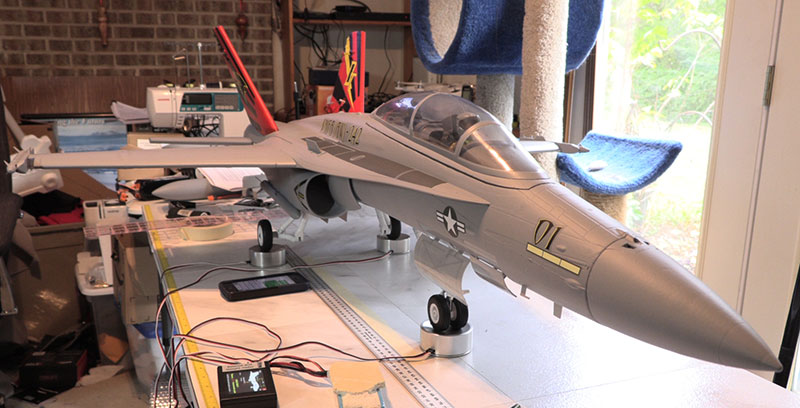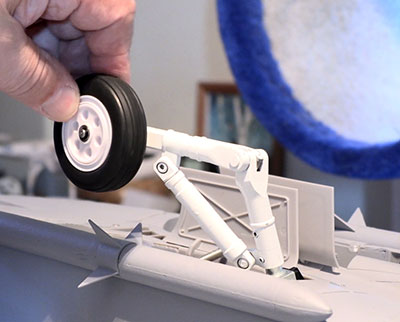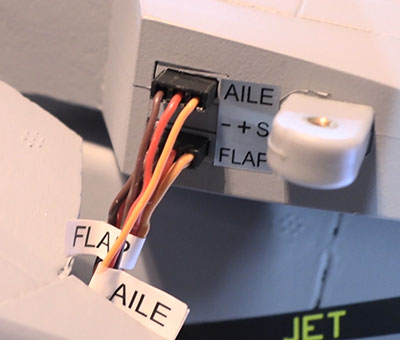



The EDF jets are getting better looking all the time.
Text, photos and video by Tom Hintz
Posted – 11-5-2019
I’ve always liked the looks of the F-18 in its various forms so when I stumbled across the newly released E-flite F-18 Hornet 80mm EDF (EFL3950) what little jet-resistance I had left slipped away. An email to my friends at Anderson RC (Thomasville, NC) confirmed my suspicions that as usual, he had one, now for me. A 40-minute ride later I had an E-flite F-18 Hornet 80mm EDF in the back of the car and was making my best jet noises all the way home.
The E-flite F-18 Hornet 80mm EDF has a wingspan of 38.6" (980mm) and an overall length of 53.1" (1350mm) and a projected flying weight of 6.6-7.5lbs (2.99-3.4kg). It is made of EPO foam that is both tough and allows a surprising amount of scale detail to be molded in. My E-flite F-18 Hornet 80mm EDF came out at 6.81lbs with battery, ready for flight.
It comes with a 3270 2000Kv brushless inrunner motor driving a V2 12-blade 80mm fan controlled by an installed 100A Pro-Switch Mode speed control with an EC5 connector. The suggested battery range is 6S 22.2V 4000-8000mAh 30C LiPo. I chose to use 5000mAh packs with a 50C rating.
The E-flite F-18 Hornet 80mm EDF comes with 100 degree rotating electric trailing link main gear retracts along with a steerable nose gear retract with operational doors. The main and nose gear are sprung to make landings easier with less shock transmitted to the airframe.

Trailing link mains give the F-18 a more realistic look.
Ten 13g metal gear servos are factory installed for connection to the AR636B AS3X receiver. The wings and vertical stabs have their servos installed with connectors provided at the mounting points to simplify assembly. All the cables are labeled to prevent crossing things up.
Some of the scale appearance features are removable ordnance, drop tanks, panel lines and retracts with most features seen on the real thing. You also find wing tip LED, red and green nav lights. The canopy contains a pilot bust that goes with the factory-installed VMFA(AW)-242 "Bats" squadron markings.
The twin vertical stabs and rudders promise better than average yaw control. The full-flying horizontal stabs/elevators should tell encourage more rational pilots to stick with the recommended deflections until you get enough stick time to get used to it.
The E-flite F-18 Hornet 80mm EDF BNF (bind and fly) version comes with the AR363B receiver installed and configured. Most pilots will fly this plane on the factory settings. Horizon product support told me that the AS3X firmware is “unlocked” in the E-flite F-18 Hornet 80mm EDF which means it can be connected to the AS3X app and the settings adjusted if you wish to do so. My plan is to fly the E-flite F-18 Hornet 80mm EDF for an extended time before even thinking about changing the AS3X system, it I ever do change it.
This receiver also has Spektrums “SAFE” technology built in. The instruction manual describes how to bind the receiver to your transmitter with the SAFE on or off. I chose not to enable SAFE in my E-flite F-18 Hornet 80mm EDF.
As advertised, building the E-flite F-18 Hornet 80mm EDF is quick. The only issues I encountered were a bit of glue contamination in one of the vertical stab mounts and the elevator “horns” needed a bit of sanding around their edges to allow sliding in their slots. These arms slide back and forth to allow fine-tuning the elevator angle at servo zero. I did have to move one elevator servo arm two spines to get that angle perfect on both sides. In the world of assembling ARF’s (almost ready to fly) these issues are insignificant.
Except for the elevators, the remaining control surfaces were perfectly aligned out of the box. After binding the AR636B receiver I also noted that all control movements were in the correct direction. I set up the dual rates at the suggested deflections and that process went quickly. I should note when you set the elevators, the travel measurement is taken at their leading edge, not the trailing edge. Because of the pivot point location there is a huge difference in travel.

Marked sockets make installing the wing fast and safe.
There appears to be a little disconnect between the CG (center of gravity) dimension listed in the manual and the illustrations indicating its location. I once again pulsed Horizon product support and was told the 70 to 78mm back from the wing root leading edge is correct.
<Balancing the E-flite F-18 Hornet 80mm EDF turned out to be simple. The battery bay has plenty of room to move all the suggested battery capacities forward or back to bullseye the CG point or to make small changes later after you get some stick time. I’m using two different battery brands that have a weight difference so balanced the E-flite F-18 Hornet 80mm EDF with both and marked the battery bay with both of their locations. It isn’t a big difference but the simplicity of balancing the E-flite F-18 Hornet 80mm EDF lets us dial it in for both packs to eliminate any small handling differences.
I must admit having been a little suspect of E-flite planes in the past but the E-Flite Viper 70mm EDF and now the E-flite F-18 Hornet 80mm EDF have won me over. The E-flite F-18 Hornet 80mm EDF has a surprising amount of detail for a “foamy” and maintains all the great looks of this venerable warbird. The overall fit and finish also shows manufacturers in general and E-Flite in particular are striving to produce planes that not only fly well but look great when not in the air.
I paid $469.99 (10-21-2019) for my E-flite F-18 Hornet 80mm EDF. Considering that it comes with a bunch of metal gear servos, retracts and a dialed-in AS3X system all factory installed, I don’t consider the purchased price to be unreasonable in today’s RC world.
Stay tuned. Though since buying the E-flite F-18 Hornet 80mm EDF the weather went from way too hot to winter-level cold, I hope to fly this warbird soon. We will do our best to get footage of that. But, get ready for some blurred video if the stories of speed are true. I promise to throttle back some to let you see how great it looks in the air.
Have a comment on this Review? –Email Me!
Visit the E-flite F-18 Hornet 80mm EDF product page – Click Here
Check out Anderson RC, my go-to shop even though it is 45-minutes away! -Click Here